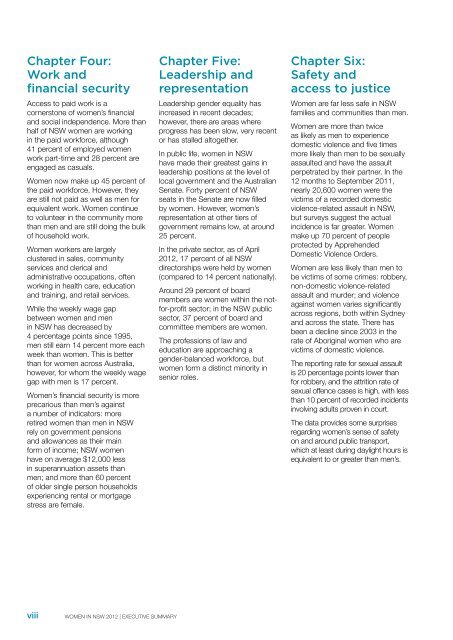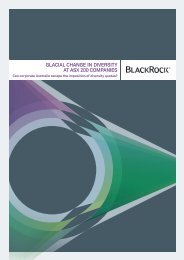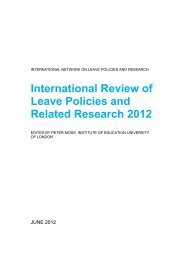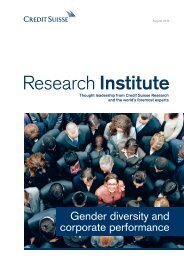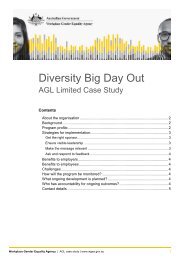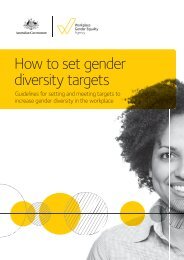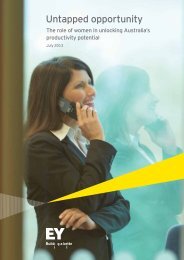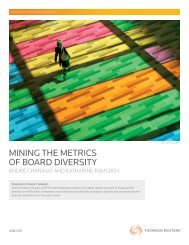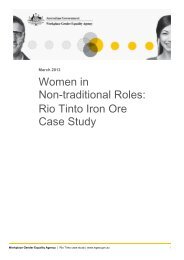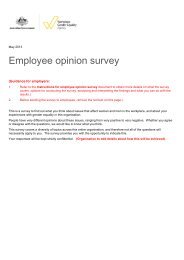Women in NSW 2012 - The Workplace Gender Equality Agency
Women in NSW 2012 - The Workplace Gender Equality Agency
Women in NSW 2012 - The Workplace Gender Equality Agency
You also want an ePaper? Increase the reach of your titles
YUMPU automatically turns print PDFs into web optimized ePapers that Google loves.
Chapter Four:Work andf<strong>in</strong>ancial securityAccess to paid work is acornerstone of women’s f<strong>in</strong>ancialand social <strong>in</strong>dependence. More thanhalf of <strong>NSW</strong> women are work<strong>in</strong>g<strong>in</strong> the paid workforce, although41 percent of employed womenwork part-time and 28 percent areengaged as casuals.<strong>Women</strong> now make up 45 percent ofthe paid workforce. However, theyare still not paid as well as men forequivalent work. <strong>Women</strong> cont<strong>in</strong>ueto volunteer <strong>in</strong> the community morethan men and are still do<strong>in</strong>g the bulkof household work.<strong>Women</strong> workers are largelyclustered <strong>in</strong> sales, communityservices and clerical andadm<strong>in</strong>istrative occupations, oftenwork<strong>in</strong>g <strong>in</strong> health care, educationand tra<strong>in</strong><strong>in</strong>g, and retail services.While the weekly wage gapbetween women and men<strong>in</strong> <strong>NSW</strong> has decreased by4 percentage po<strong>in</strong>ts s<strong>in</strong>ce 1995,men still earn 14 percent more eachweek than women. This is betterthan for women across Australia,however, for whom the weekly wagegap with men is 17 percent.<strong>Women</strong>’s f<strong>in</strong>ancial security is moreprecarious than men’s aga<strong>in</strong>sta number of <strong>in</strong>dicators: moreretired women than men <strong>in</strong> <strong>NSW</strong>rely on government pensionsand allowances as their ma<strong>in</strong>form of <strong>in</strong>come; <strong>NSW</strong> womenhave on average $12,000 less<strong>in</strong> superannuation assets thanmen; and more than 60 percentof older s<strong>in</strong>gle person householdsexperienc<strong>in</strong>g rental or mortgagestress are female.Chapter Five:Leadership andrepresentationLeadership gender equality has<strong>in</strong>creased <strong>in</strong> recent decades;however, there are areas whereprogress has been slow, very recentor has stalled altogether.In public life, women <strong>in</strong> <strong>NSW</strong>have made their greatest ga<strong>in</strong>s <strong>in</strong>leadership positions at the level oflocal government and the AustralianSenate. Forty percent of <strong>NSW</strong>seats <strong>in</strong> the Senate are now filledby women. However, women’srepresentation at other tiers ofgovernment rema<strong>in</strong>s low, at around25 percent.In the private sector, as of April<strong>2012</strong>, 17 percent of all <strong>NSW</strong>directorships were held by women(compared to 14 percent nationally).Around 29 percent of boardmembers are women with<strong>in</strong> the notfor-profitsector; <strong>in</strong> the <strong>NSW</strong> publicsector, 37 percent of board andcommittee members are women.<strong>The</strong> professions of law andeducation are approach<strong>in</strong>g agender-balanced workforce, butwomen form a dist<strong>in</strong>ct m<strong>in</strong>ority <strong>in</strong>senior roles.Chapter Six:Safety andaccess to justice<strong>Women</strong> are far less safe <strong>in</strong> <strong>NSW</strong>families and communities than men.<strong>Women</strong> are more than twiceas likely as men to experiencedomestic violence and five timesmore likely than men to be sexuallyassaulted and have the assaultperpetrated by their partner. In the12 months to September 2011,nearly 20,600 women were thevictims of a recorded domesticviolence-related assault <strong>in</strong> <strong>NSW</strong>,but surveys suggest the actual<strong>in</strong>cidence is far greater. <strong>Women</strong>make up 70 percent of peopleprotected by ApprehendedDomestic Violence Orders.<strong>Women</strong> are less likely than men tobe victims of some crimes: robbery,non-domestic violence-relatedassault and murder; and violenceaga<strong>in</strong>st women varies significantlyacross regions, both with<strong>in</strong> Sydneyand across the state. <strong>The</strong>re hasbeen a decl<strong>in</strong>e s<strong>in</strong>ce 2003 <strong>in</strong> therate of Aborig<strong>in</strong>al women who arevictims of domestic violence.<strong>The</strong> report<strong>in</strong>g rate for sexual assaultis 20 percentage po<strong>in</strong>ts lower thanfor robbery, and the attrition rate ofsexual offence cases is high, with lessthan 10 percent of recorded <strong>in</strong>cidents<strong>in</strong>volv<strong>in</strong>g adults proven <strong>in</strong> court.<strong>The</strong> data provides some surprisesregard<strong>in</strong>g women’s sense of safetyon and around public transport,which at least dur<strong>in</strong>g daylight hours isequivalent to or greater than men’s.viiiWOMEN IN <strong>NSW</strong> <strong>2012</strong> | EXECUTIVE SUMMARY


